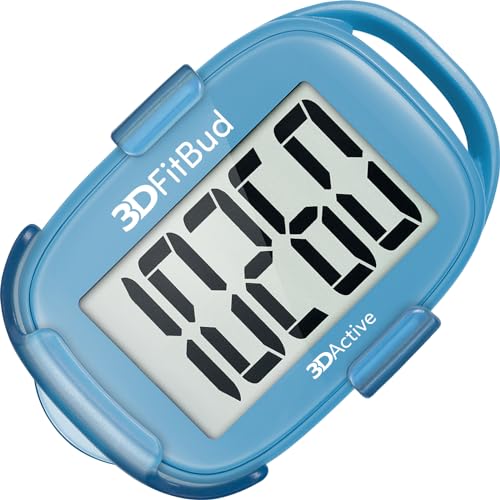Are you looking for a simple way to get more active without breaking the bank? Pedometers might be your new best friend. In this comprehensive guide, we’ll walk you through everything you need to know about pedometers – what they are, how they work, their benefits, accuracy, how they compare to smartwatches, and even some affordable pedometer picks for your family.
What Is a Pedometer and What Is It Used For?
A pedometer is a small device (often clip-on or wearable) that counts each step you take by detecting motion. Essentially, it’s a step-counter. Pedometers have been around for ages – even Thomas Jefferson used one to track his walking back in the 1700s!.
What do you use a pedometer for? Primarily, to track your steps throughout the day. Early pedometers were popular among athletes and walkers, but nowadays many people use pedometers as an everyday fitness motivator. Clip one onto your waistband in the morning, and it will tally how many steps you walk during daily activities – whether you’re doing school drop-offs, grocery runs, walking the dog, or just pacing around the house tidying up. At the end of the day, you get a simple number: your total steps walked.
People use pedometers to set goals and stay motivated. For example, you might aim for 8,000 steps a day and use the pedometer to keep yourself accountable. It’s surprisingly fun to watch the steps climb! Families often turn this into a friendly competition – kids and parents comparing who took more steps. In short, a pedometer is used to encourage more movement by making you aware of how active (or inactive) you are in a day.
Bottom line: A pedometer is a no-fuss gadget to count your steps and distance walked. It’s used for tracking activity and nudging you to move more for better health.

How Does a Pedometer Work?
Traditional pedometers use a mechanical sensor – often a tiny pendulum or ball that moves with each step, triggering a step count. If you ever used an old-school pedometer, you might have heard a little click or felt something moving inside when you walked. These needed to be worn upright (usually at your waist) to work properly, because they relied on the vertical motion of your hips with each step.
Modern pedometers, however, use advanced motion sensors called accelerometers. These 3-axis accelerometers detect movement in all directions, which means you can carry them in a pocket, bag, or around your neck and they’ll still count steps. The sensor and software together distinguish step-like motions from other motions. Every time you take a step and your body jolts ever so slightly, the pedometer’s sensor picks it up and adds to your step count.
Some pedometers are now built into other devices. Smartphones and smartwatches have pedometer functions by using their built-in accelerometers to count steps. But the standalone pedometer is simple: basically if it senses a footstep motion, it counts it. With a bit of math (multiplying steps by your average stride length), many pedometers also estimate distance walked. For instance, if your stride is about 2.5 feet, then roughly 2,000 steps equal a mile. (Fun fact: the word “mile” actually comes from the Latin mille passuum, meaning “one thousand paces” – roughly 2,000 steps!).
In short: Pedometers work by sensing your body’s movement each time you step. Older ones use a little pendulum mechanism, while newer ones use electronic sensors. Either way, they turn your movement into a step count on the screen.
Benefits of Using a Pedometer
Why bother wearing a pedometer? It turns out this tiny device can have a big impact on your lifestyle and fitness habits:
- Motivation to Move More: Seeing your step count can be surprisingly motivating. If it’s 6 PM and you notice you’re at 7,500 steps, you might be inspired to take an after-dinner walk to hit your 10,000-step goal. Research has shown that people significantly increase their physical activity when using pedometers compared to when they don’t track steps. It’s like having a friendly coach on your hip, gently nudging you to take a few more steps.
- Simple Fitness Tracking: Unlike complicated fitness gadgets, pedometers are simple. You don’t need to input tons of data or learn a new app. Most have one primary function – counting steps – which makes them very user-friendly. Busy moms and dads love that you can just clip it on and go. No fuss.
- Goal Setting and Accountability: Pedometers make it easy to set concrete goals (like a step goal per day) and track your progress. They provide an objective measure of your activity. This can be great for families too – you can set up fun step challenges (kids vs. parents, perhaps) to get everyone moving.
- Health Benefits: Walking more is linked to myriad health benefits – from weight management to lower blood pressure and improved mood. A pedometer can help you gradually increase your daily steps, which over time can contribute to better health. In fact, one study found pedometer users not only walked more but also saw decreases in their BMI and blood pressure over time. All from just walking more!
- Affordable & No Ongoing Cost: Pedometers are generally inexpensive, especially compared to smartwatches or gym memberships. You can find basic models for $10-$30. There’s no subscription fee, and many use a simple coin battery that lasts months (or even a year) without replacement. It’s a budget-friendly fitness tool – perfect for thrifty folks.
- Awareness of Activity Levels: Perhaps one of the biggest benefits is awareness. You might feel like you’ve been “on your feet all day,” but the pedometer’s number might tell a different story (I’ve had those days where it barely ticked 3,000!). Wearing a pedometer can clue you in to how much you actually move and help identify opportunities to fit in more walking – like pacing during phone calls or taking the stairs more often.
In summary, a pedometer is an uplifting little gadget: it encourages you, keeps you accountable, and rewards you with a sense of accomplishment when you hit your goal. All without requiring much time or money – a win for busy, budget-conscious families.

Are Pedometers Accurate?
One common question is whether you can trust the step counts on these devices. The answer: good pedometers are reasonably accurate, but no device is perfect. Here’s what to know:
- Modern Pedometers (3D Accelerometer types) – Quality pedometers today are pretty accurate when used correctly. The best pedometers have an error margin of around ±5%, meaning the count could be off by a small amount. For everyday purposes, that’s fine. For example, if you walked 5,000 steps, a top pedometer might be within ~250 steps of the actual count.
- Proper Placement Matters: To get the most accurate readings, wear the pedometer as recommended. For clip-on devices, that usually means vertically on your belt or waistline, roughly above your hip. This position near your center of mass often yields the best step detection. If a pedometer swings or is at a strange angle, it might under-count or over-count. The good news is that newer pedometers with tri-axis sensors are more forgiving – they can track well even in a pocket or purse. But it’s still wise to keep it secure and upright if possible.
- False Steps: All pedometers can occasionally count “steps” that aren’t steps. Ever notice extra steps when you’re driving on a bumpy road or when you drop the pedometer on a table? Vibrations and jostling can trick the sensor. Advanced models try to filter these out (for example, some pedometers won’t count a motion as a step unless it falls within a typical step rhythm or force). Wrist-worn devices (like fitness watches) may count arm motions as steps, whereas a hip-worn pedometer might be less prone to that error. So each has some inaccuracy in different situations.
- Walking Speed: Older pedometers especially might miss steps if you’re walking very slowly or shuffling (like with a stroller or walker). At very slow speeds, some devices under-count steps. Fortunately, for normal walking pace and above, most pedometers capture steps well. If you’re concerned about accuracy while, say, leisurely strolling or if an elderly family member uses it with a very gentle gait, you might want a higher-quality model that’s been noted for accuracy at slow speeds.
- Step Length Calibration: If your pedometer shows distance, you usually input your estimated stride length. This can introduce error in distance calculation (if your guess is off). It doesn’t affect the step count itself. To improve distance accuracy, measure your stride by walking a known distance (like a track) and dividing distance/steps to get a true stride length.
Overall, pedometers are accurate enough for personal fitness goals. Think of the step count as a close estimate. If it says 9,500 and you were targeting 10,000, you probably got about that many steps. The key is consistency: use the same device and placement daily, and you’ll be able to track trends (like increasing your average steps over time). For everyday use, a small margin of error won’t derail your progress.
Tip: If accuracy is a big concern for you, opt for a well-reviewed pedometer. In research tests, pedometers worn on the hip often serve as a “gold standard” for step counting because they avoid the extra arm motion issue that wrist trackers have. In fact, one analysis found many popular wrist activity trackers overcount steps by 20%+ on average (counting extra hand movements as steps). A simple hip pedometer can actually be more accurate for step counts alone. Good to know, right?

Pedometer vs. Smartwatch: What’s the Difference?
These days, many people count steps using a smartwatch or fitness band (like a Fitbit, Apple Watch, Garmin, etc.) instead of a classic pedometer. Both essentially do the same basic job – counting steps – but there are some key differences:
- Features: A pedometer is a single-purpose gadget – it counts steps (and maybe estimates distance and calories). A smartwatch/fitness tracker is multi-purpose. It not only counts steps, but often also monitors heart rate, tracks sleep, can log different exercises, shows smartphone notifications, etc. Think of a smartwatch as a pedometer plus a bunch of other tech. If you only care about step counting, a pedometer’s simplicity can be refreshing. If you love data and extras, a smartwatch offers a lot more.
- Accuracy: As mentioned, when it comes to pure step counting, a clip-on pedometer on your waist can be very accurate – often more so than wrist devices that might count random arm motions as steps. Smartwatches use similar accelerometer sensors for steps, but their placement on the wrist means they sometimes log non-walking movement. This doesn’t mean smartwatches are bad at counting steps (most are quite good during actual walking/running), but you might see your step count go up while folding laundry or cooking (those darn arm swings!). Pedometers worn on the hip are generally less susceptible to that kind of false count.
- Battery Life & Convenience: Pedometers typically have excellent battery life. Many run on a watch battery that lasts 6-12 months, or they’re rechargeable but only need charging every few months. You can wear it all day and not worry about nightly charging. Smartwatches, on the other hand, often require charging every day or every few days (especially if using power-hungry features). If you’re a busy parent, remembering to charge another device might be a hassle. Pedometers are usually grab-and-go. Also, pedometers are so lightweight and small you might forget you’re wearing one. Some smartwatches are bulkier on the wrist (though there are slim fitness bands too).
- Cost: This is a big one for thrifty families. A basic pedometer can cost under $20 and does not require any paid apps or subscriptions. A brand-name smartwatch or fitness tracker can range from $50 on the low end to $200+ for advanced models. If you’re watching your budget, a pedometer delivers the core function (step tracking) at a fraction of the price. You can always use your smartphone’s free health app for occasional step tracking too, but a pedometer is more convenient than carrying your phone everywhere.
- Who Might Prefer Each: If you love tech, want all your health metrics in one place, or plan to use features like heart-rate based workouts, GPS mapping of runs, texting from your watch, etc., then a smartwatch or fitness tracker is worth considering. But if you just want to know “Did I move enough today?” and be nudged to walk more, a simple pedometer is an easy, low-cost solution. Some people actually prefer not having the distractions of a smartwatch (no buzzing notifications or complicated setup).
- Data Syncing: A pedometer is usually a stand-alone device. You look at the number on it and maybe write it down if you’re logging progress. A smartwatch syncs with an app, showing you fancy graphs and storing long-term data. That can be cool, but again, it’s more than some folks want. There are actually pedometers that have Bluetooth and apps too, bridging the gap – but those start creeping up in price toward fitness tracker territory.
In summary: A smartwatch is like a multi-tool, and a pedometer is like a trusty screwdriver dedicated to one job. Both count steps well, but pedometers win on simplicity, battery life, and price, whereas smartwatches win on features and integration. If you’re on the fence, think about your personal needs. Many busy moms find that a no-frills pedometer is less intimidating and more kid-friendly (you could even give the kids their own $10 step counter for fun). Plus, there’s something satisfying about the single goal a pedometer provides – it’s not pinging you about texts or other metrics – just steps.
Tip: Already have a smartwatch? Feel free to use it as your pedometer – no need to buy a separate device if you’re happy with it. But if you don’t have one or don’t want to wear a screen on your wrist, a pedometer is a fantastic alternative.
How Many Steps Should I Take a Day?
We often hear the magic number “10,000 steps a day.” To be sure, 10,000 steps (about 5 miles) is a popular goal and a great achievement if you hit it. But do you need 10k steps daily? The origin of that number is actually pretty interesting – it started as a 1960s Japanese marketing slogan for a pedometer (“10,000-step meter”), and it stuck as a general guideline for an active lifestyle.
Recent research suggests you can see major health benefits around 7,000-8,000 steps per day. For example, one large study found that people averaging ~7,000 steps a day had significantly lower mortality risk than those doing less, even if they didn’t hit 10k every day. The benefit tends to level off around 10k – meaning going much above 10k steps gives only marginal extra health benefits for most people. So, no, 10,000 isn’t a hard requirement for good health. It’s just a nice round number that encourages people to move more.
Practical recommendations:
- If you’re currently inactive, start by finding out your baseline. Use a pedometer for a few days to see how many steps you naturally take. Let’s say it’s around 3,000. In that case, trying to jump straight to 10,000 might be overwhelming. Instead, aim to add 1,000–2,000 extra steps a day for a few weeks. That could be as simple as a 15-20 minute walk in the evening (which is roughly 2,000 steps). Gradually increase your goal as you feel ready.
- A common goal range for adults is 6,000-8,000 steps per day for general health, and up towards 10,000 if possible for additional fitness or weight management. The U.S. Surgeon General has recommended 10k as a benchmark for active living, but again, it’s not one-size-fits-all.
- Listen to your body: The point is to get more activity than you were getting before. If you have joint issues or health concerns, consult with a doctor on a suitable goal. Some people (like older adults or those managing chronic conditions) might set a lower target and still benefit greatly from it. On the flip side, very active kids or athletes will blow past 10k easily and might set higher goals.
- Quality vs Quantity: Remember, step counts don’t measure exercise intensity. 10,000 leisurely steps spread out over a day is great for overall movement, but incorporating some faster walking can boost fitness more. Health authorities often suggest 150 minutes of moderate exercise a week, which brisk walking can help achieve (about 30 minutes a day) – that might be ~3,000-4,000 brisk steps. Using your pedometer in combination with these guidelines can be helpful: for example, aiming for bouts of faster stepping in your day, not just the total number.
In our family, we treat step goals as a fun challenge, not a rigid rule. Some days you’ll hit your goal, some days you won’t – and that’s okay. The pedometer resets tomorrow! Over time, you might find your daily average creeping up, which is exactly what we want. Anything that gets you moving a bit more is a win. Whether it’s 5,000 or 10,000, the best number of steps is the one that nudges you towards a healthier, more active lifestyle.

How Many Steps Are in a Mile?
Many of us use step counts to estimate distance. While it varies from person to person, a general rule of thumb is that ~2,000 steps equal about 1 mile (1.6 kilometers). This is based on an average stride length (approximately 2.2 to 2.5 feet per step for an adult). If you have a longer stride or you’re tall, your steps might be fewer per mile (maybe 1,900 = 1 mile). If you’re shorter or take smaller steps, it could be more (2,300–2,500 steps in a mile).
Many pedometers will do this math for you if you’ve input your stride length – they’ll display distance in miles or km in addition to steps. Just remember those distance readings are estimates. If you want a highly accurate distance, using a phone GPS or a measured track is better. But for casual walking, the steps-to-miles conversion (2000:1) is a handy reference.
Note: If you’re specifically training for something like a 5K run or a charity walk of a known distance, it’s worth calibrating your steps. You could use a smartphone GPS one day to see how many steps you personally take in a mile. However, for most purposes, you can trust that roughly 10k steps is around 5 miles, 5k steps is ~2.5 miles, and so on.

Best Pedometers (Affordable Picks for Every Need)
Whether you’re looking for a no-frills step counter or a pedometer with a few bells and whistles, we’ve got you covered. Here are 6 pedometers to consider, with a mix of basic and feature-rich models:
1. 3DActive 3DFitBud Simple Step Counter
- Pros: Ready to use straight out of the box (no setup needed), very easy one-button operation, large easy-to-read display, and long battery life (battery lasts ~1 year). It’s also compact and lightweight.
- Cons: It only tracks steps – no distance or calories. The clip is handy, but if jostled a lot (like on kids jumping around), it can occasionally slip (and the clip isn’t super tight according to some).
- Ideal for: Anyone who wants a basic, no-fuss pedometer, including seniors and kids. It comes in multiple fun colors, which kids love. Also great if you’re not tech-savvy – there’s literally no app or smartphone required.
- Why we picked it: The 3DFitBud is often touted as one of the best no-frills pedometers. Reviewers praise its accuracy and simplicity – you can clip it on or wear it on a lanyard and just start walking. We love that it’s affordable (usually around $25 or less) and you don’t have to fiddle with any programming. Just reset it in the morning and go. It’s an excellent choice for starting a family step challenge or for someone who just wants to dip their toes into tracking steps without any learning curve.
- 🚶🏼 ✅ SIMPLE & EASY TO USE ✅ – 3D Pedometer for Steps Only. It is ready to use straight out of the package. The simple fe…
- 🚶🏼 ✅ TRACK YOUR DAILY STEPS ✅ – Created with simplicity but effectively counts your steps so you can still view your pro…
- 🚶🏼 ✅ ACCURATE READING ✅ – It has advanced 3D Tri-Axis Sensor technology – much more accurate than most pedometers. 3D Tr…
2. NESKLA 3D Pedometer (Large Display)
- Pros: Extra-large display that shows your step count at a glance, very user-friendly with simple setup, and a long 12-month battery life. It’s thin, lightweight, and clips securely. Extremely accurate for step counting in testing.
- Cons: The clip can be a bit stiff – some users find it hard to pinch open (on the plus side, it means it stays put once on). Also, like the FitBud, it’s a basic step counter (no fancy metrics).
- Ideal for: Those who want an easy-to-read screen – we especially recommend it for seniors or anyone with not-so-great eyesight. The numbers on this device are bigger than most, so you don’t have to squint or put on glasses to check your steps. Also great for walkers who value accuracy and simplicity.
- Why we picked it: The NESKLA 3D Pedometer earned a reputation as a top pick for seniors in some reviews precisely because of its simplicity and large display. We included it because sometimes the little things – like a clear display – make a big difference in daily use. It has a solid build and does one thing very well: count steps reliably. If you’re getting one for Grandma, Grandpa, or anyone who says “I just want to see my steps easily,” this is a fantastic choice (and it’s budget-friendly, roughly $15-$20).
- SIMPLE & EASY TO USE: 3D Pedometer for Steps Only. No Bluetooth, no app or smartphone connections required. Only one res…
- ACCURATE COUNTING: Pedometer has advanced 3D Tri-Axis Sensor technology, so it is much more accurate than most pedometer…
- EASY TO READ: With large LCD multi-function display, you can clearly and easily read the numbers at a glance. Makes it t…
3. Beroziyesi 3D Pedometer
- Pros: Ultra-affordable (often around $10-$15), arrives ready to go (no setup, no charging needed), and has excellent battery life (about 1 year on a replaceable battery). It counts up to 99,999 steps in a single run – far more than most of us will ever hit in a day, but good to know it can handle ultra-long walks or multi-day counts. It’s simple and no-frills, just what you need to get the job done.
- Cons: It doesn’t track distance or calories – strictly steps. Also, it’s reported to be not quite as pinpoint accurate as some higher-end models. In practical terms, that might mean it could count a few extra steps or miss a few in certain conditions, but overall it’s fine for casual use.
- Ideal for: Walkers on a tight budget who just want a straightforward step count. Also, if you plan very long hikes or multi-day treks and want to count an enormous number of steps, this pedometer can handle high counts without resetting. Its simplicity (no app, no cords) makes it good for less tech-inclined folks too.
- Why we picked it: We love highlighting this one because it proves you can get an effective pedometer for around ten bucks. Reviewers on Shape described it as “not fancy by any means, but it gets the job done”, which sums it up perfectly. You can use it straight out of the box without charging or syncing. For a budget-conscious family, you could get one for each member without much expense.
- Accurate Counting: The step tracker uses the latest 3D 3-axis sensor technology so it is more accurate than most pedomet…
- Simple and Easy To Use: 3D pedometer for Steps Only. It’s the simplest pedometer and can count up to 99999, no app no bl…
- Easy To Read: With full screen display you can clearly and easily read the numbers at a glance, so you can view your pro…
4. Omron Walking Style IV Pedometer
- Pros: Made by Omron, a trusted brand in health gadgets. It tracks steps with high accuracy and also calculates distance and calories. A standout feature is its memory: it stores up to 7 days of step data, so you can scroll through the past week’s totals right on the device. It has a clear display and intuitive navigation (as noted by testers). Battery lasts ~6 months or more, and it’s compact with a secure clip.
- Cons: It’s a bit pricier than generic pedometers – usually in the $30-$45 range. Also, while fairly compact, some might find it a tad “chunkier” than the super slim models (but it’s still small enough for pocket or belt). No backlight on the screen, so viewing in the dark is difficult (minor gripe).
- Ideal for: Someone who wants a little more than basic. If you’d like to see distance walked and calories burned along with steps – without using a separate app – this pedometer does it. It’s great for those who like the idea of daily tracking but don’t want a full-blown fitness tracker. Also, if reliability and brand reputation put your mind at ease, Omron delivers that.
- Why we picked it: Omron’s pedometers have been around for years and consistently rank high for accuracy and build quality. The Walking Style IV brings modern 3D sensor accuracy and the convenience of a week’s memory, so you can track progress over time without writing it down every day. We included it as a feature-rich yet still affordable option – it’s not the cheapest pedometer on the list, but it’s like the “premium” choice under $50. If you’re serious about walking and data, but still want something simple (no phone needed), this is a fantastic pick.
- Dual-axis pocket pedometer
- Measures steps, aerobic steps, distance, calories and fat grams burned
- Features 7-day memory, clock, automatically resets at midnight
5. Realalt 3DTriSport Pedometer
- Pros: Tracks multiple stats – not just steps, but also distance, calories, and exercise time. It has a huge memory capacity: stores 30 days of daily records for steps and other metrics. That means you can look back at the last month of activity on the device. It’s very accurate thanks to the tri-axis sensor and even allows for stride length adjustment for better distance accuracy. Comes with a clip and lanyard, and an extra battery plus an e-book walking guide (nice little bonus).
- Cons: No Bluetooth or smartphone connectivity – it’s old school in that the data stays on the device (which some might consider a pro, actually, since there’s no app fuss). Setting up the time, date, weight, and stride on initial use is a bit more involved than a one-button pedometer (you might need to read the manual or a quick YouTube tutorial for setup, especially to utilize all features). It’s also slightly larger than the ultra-mini pedometers, but still pocketable.
- Ideal for: Walkers who want a comprehensive picture of their activity without needing a smartwatch. If you like to see your distance and calories, or keep a log of your improvements, the 30-day memory is gold. It’s also a great choice for folks who might be doing a step challenge or training program and want to track over several weeks. Because it has a lanyard, it’s a good option if you’re afraid of losing small gadgets – you can wear it around your neck or even tie it to your shoelaces.
- Why we picked it: Realalt’s 3DTriSport is often top-rated in pedometer reviews for accuracy and functionality. We appreciate that it bridges the gap between basic pedometer and fitness tracker, without the higher cost. You get a lot of features (distance, calories, long memory) for around $25. It’s like a pedometer on steroids (the good kind!). One tester noted it’s extremely accurate and intuitive to use once set up. We also like that you can forget about it for a whole month and later see, for example, “Oh wow, on March 3rd I walked 5 miles!” It’s a neat tool for someone serious about gradually increasing their activity and wanting to document it – all while staying budget-conscious.
- ✅ ACCURATELY TRACK YOUR ACTIVITY ✅ – The 3DTriSport Walking 3D Pedometer uses the latest 3D Tri-Axis Sensor Technology t…
- ✅ EASY TO SET UP & USE ✅ – Looking for a Simple Pedometer to Set Up? The 3DTriSport Pedometer is the Perfect Choice! Eas…
- ✅ SMART ACCURATE ✅ – With the latest 3D Tri-Axis Sensor Technology to Accurately Record your Activity in any position – …
6. Fitbit Inspire 3 (Fitness Tracker as a Pedometer)
- Pros: Packed with features – it counts steps, distance, calories, monitors heart rate, tracks sleep, and even gets your smartphone notifications. Essentially, it’s a slim smartwatch. It has a bright screen but still boasts about 10 days of battery life per charge, which is excellent for a device with this many features. The design is sleek and comfortable, and it’s water-resistant, so you can keep it on for dish washing, showers, or sweaty workouts. The step counting on the Inspire is very accurate in our experience (Fitbit’s algorithms are well-developed over the years).
- Cons: It’s pricier than a basic pedometer (typically around $80-$100). Also, because it’s a more advanced device, you’ll need to charge it periodically (about once a week) and sync with the Fitbit app to get the most out of it. Some features (like detailed sleep analysis) require using the app. It also can’t be charged with a universal micro-USB or USB-C; it has its own charger (so don’t lose that cable!).
- Ideal for: Someone who is considering a smartwatch or fitness tracker but maybe doesn’t want to shell out for an expensive Apple Watch or advanced Garmin. The Inspire 3 is great as a first fitness tracker – it’s relatively affordable and very easy to use. Busy moms who want to wear something on their wrist and not worry about clipping a device on each day might love this. If you’re also interested in monitoring your heart rate during workouts or tracking your sleep quality at night, this gives you those extras.
- Why we picked it: We wanted to include at least one “smart pedometer” option for readers who might be tech-curious. The Inspire 3 is part smartwatch, part pedometer – you get the best of both. We love it because it’s still fairly budget-friendly for a tracker and doesn’t overwhelm you with complexity. Many users report it’s incredibly intuitive – you can basically turn it on and start walking, and the step count is right on the home screen. Plus, Fitbit’s app can be a fun way to see your step trends, join step challenges with friends, and more. If you have a bit more money to invest and like the idea of extra health data, the Inspire 3 is a fantastic value. And yes, you can absolutely use it just to count steps if that’s mostly what you care about – it will do that and do it well, while the other features are there for you when you want them.
- Inspire 3 is the tracker that helps you find your energy, do what you love and feel your best. All you have to do is wea…
- Move more: Daily Readiness Score(1), Active Zone Minutes, all-day activity tracking and 24/7 heart rate, 20+ exercise mo…
- Stress less: always-on wellness tracking, daily Stress Management Score, mindfulness sessions, relax breathing sessions,…
Those are our top pedometer picks, balancing thriftiness with functionality. Each of these has its own strengths, so think about what fits your lifestyle best. Do you want simple and cheap? Go with something like the 3DFitBud, Neskla, or Beroziyesi. Need a bit more data? Omron or Realalt might be your jam. Want smartwatch features on a budget? Fitbit Inspire 3 has you covered.
This post may contain affiliate links, which means we might earn a small commission (at no extra cost to you) if you decide to make a purchase through one of these links. Thanks for your support!







